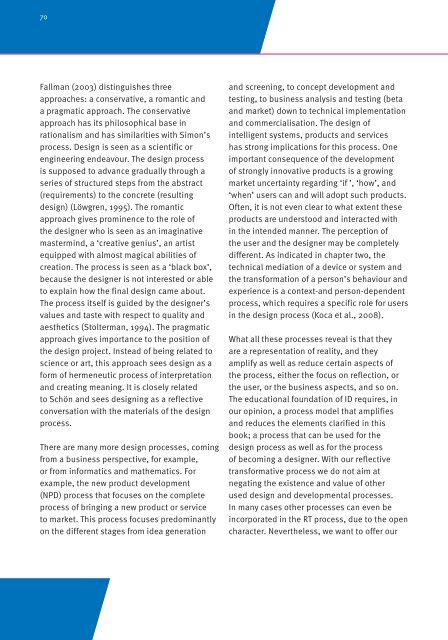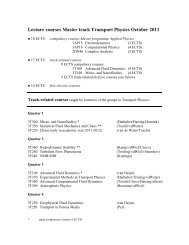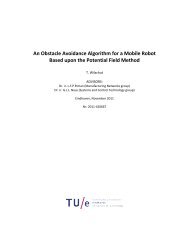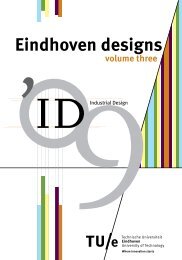Education guide 'Eindhoven designs' - Technische Universiteit ...
Education guide 'Eindhoven designs' - Technische Universiteit ...
Education guide 'Eindhoven designs' - Technische Universiteit ...
You also want an ePaper? Increase the reach of your titles
YUMPU automatically turns print PDFs into web optimized ePapers that Google loves.
70<br />
Fallman (2003) distinguishes three<br />
approaches: a conservative, a romantic and<br />
a pragmatic approach. The conservative<br />
approach has its philosophical base in<br />
rationalism and has similarities with Simon’s<br />
process. Design is seen as a scientific or<br />
engineering endeavour. The design process<br />
is supposed to advance gradually through a<br />
series of structured steps from the abstract<br />
(requirements) to the concrete (resulting<br />
design) (Löwgren, 1995). The romantic<br />
approach gives prominence to the role of<br />
the designer who is seen as an imaginative<br />
mastermind, a ‘creative genius’, an artist<br />
equipped with almost magical abilities of<br />
creation. The process is seen as a ‘black box’,<br />
because the designer is not interested or able<br />
to explain how the final design came about.<br />
The process itself is <strong>guide</strong>d by the designer’s<br />
values and taste with respect to quality and<br />
aesthetics (Stolterman, 1994). The pragmatic<br />
approach gives importance to the position of<br />
the design project. Instead of being related to<br />
science or art, this approach sees design as a<br />
form of hermeneutic process of interpretation<br />
and creating meaning. It is closely related<br />
to Schön and sees designing as a reflective<br />
conversation with the materials of the design<br />
process.<br />
There are many more design processes, coming<br />
from a business perspective, for example,<br />
or from informatics and mathematics. For<br />
example, the new product development<br />
(NPD) process that focuses on the complete<br />
process of bringing a new product or service<br />
to market. This process focuses predominantly<br />
on the different stages from idea generation<br />
and screening, to concept development and<br />
testing, to business analysis and testing (beta<br />
and market) down to technical implementation<br />
and commercialisation. The design of<br />
intelligent systems, products and services<br />
has strong implications for this process. One<br />
important consequence of the development<br />
of strongly innovative products is a growing<br />
market uncertainty regarding ‘if ’, ‘how’, and<br />
‘when’ users can and will adopt such products.<br />
Often, it is not even clear to what extent these<br />
products are understood and interacted with<br />
in the intended manner. The perception of<br />
the user and the designer may be completely<br />
different. As indicated in chapter two, the<br />
technical mediation of a device or system and<br />
the transformation of a person’s behaviour and<br />
experience is a context-and person-dependent<br />
process, which requires a specific role for users<br />
in the design process (Koca et al., 2008).<br />
What all these processes reveal is that they<br />
are a representation of reality, and they<br />
amplify as well as reduce certain aspects of<br />
the process, either the focus on reflection, or<br />
the user, or the business aspects, and so on.<br />
The educational foundation of ID requires, in<br />
our opinion, a process model that amplifies<br />
and reduces the elements clarified in this<br />
book; a process that can be used for the<br />
design process as well as for the process<br />
of becoming a designer. With our reflective<br />
transformative process we do not aim at<br />
negating the existence and value of other<br />
used design and developmental processes.<br />
In many cases other processes can even be<br />
incorporated in the RT process, due to the open<br />
character. Nevertheless, we want to offer our

















